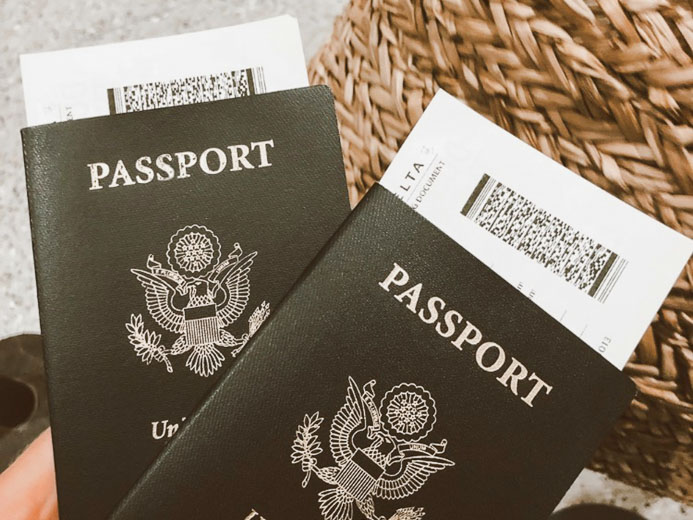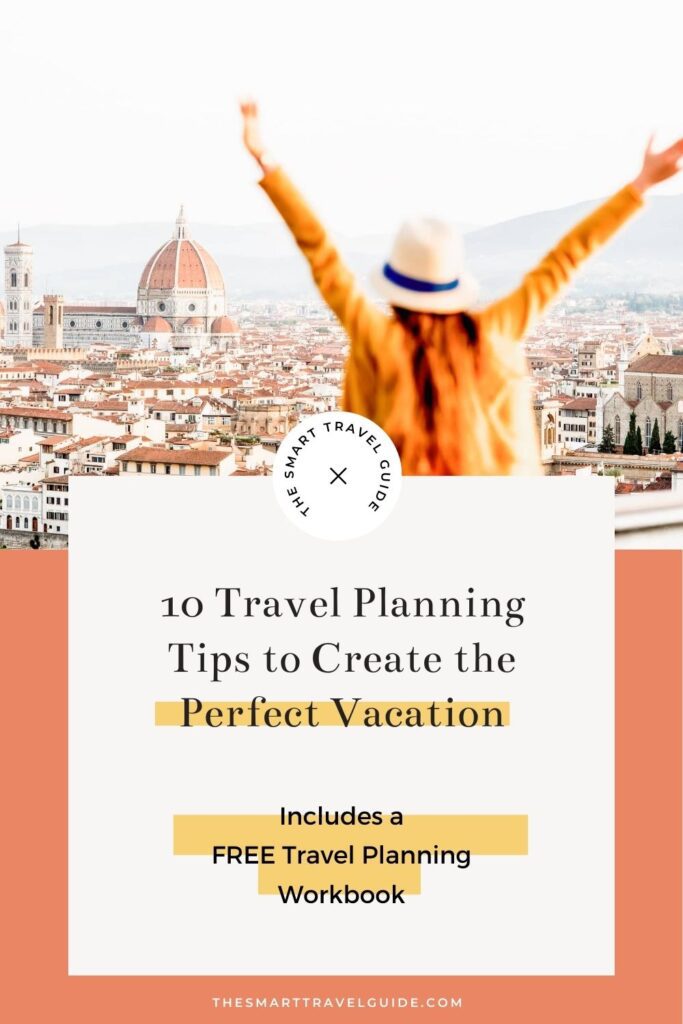TIME TO READ, 22 MINUTES
I’m so happy you found this post because I have the 10 best travel planning tips for you to follow to create an exciting, safe, and unforgettable dream vacation, whether you’re a new traveler who needs all the details or a seasoned traveler who just needs a checklist.
How exciting is this! You’re planning a trip.
There’s sooooo much to do, right? I hear you. Planning a trip after 50 may seem daunting, but it doesn't have to be. With the 10 travel planning tips below, you can create a memorable and enjoyable vacation, whether you're traveling for the first time to another state or are a seasoned road warrior looking for international plane travel tips.
I know what it can be like. I’ve traveled a lot, flying over 2.5 million miles and sometimes staying in a location for 3 months or longer. I’ve been to most of the 50 states and have traveled to 49 countries, much of this since I turned 50.
I’ve been there, trying to decide what to wear, how it’s all going to fit in the suitcase, and how I’ll lift my overstuffed carry-on into the overhead without relying on some handsome guy to heft it up for me.
I know what it’s like, worrying about my checked luggage getting lost. (Remind me sometime to tell you about 3 days in Brazil—steaming hot and humid Brazil—with just the clothes I wore on the plane. Boy, did I learn my lesson that time!)
So, with these 10 travel planning tips, I’ve got you covered whether you’re traveling on a short US trip or an around-the-world excursion.
Why Take Time to Plan a Trip?
According to a study reported in the Boston Globe, more than 90% of Americans find travel stressful. How can you reduce that stress? Have a good, solid plan for your trip.
Whether you're looking to explore a new destination or revisit a favorite spot, the following 10 travel planning tips will help you plan a memorable trip that meets your needs and budget while reducing most, if not all, travel stress.
So grab a notebook and pen, and let's do this! Download the corresponding travel planner and take notes as you go.
Tip #1: Describe Your Dream Vacation
 Tip #1 is to decide what kind of trip you want to take. Do you already have your dream vacation in mind? If so, these questions will help you make sure you have everything covered. If not, let’s set some parameters.
Tip #1 is to decide what kind of trip you want to take. Do you already have your dream vacation in mind? If so, these questions will help you make sure you have everything covered. If not, let’s set some parameters.
What kind of trip do you want to take?
Close your eyes and picture yourself on your perfect vacation.
- Are you doing something active like skiing or hiking, or are you relaxing at a spa or resort?
- Are you on a romantic getaway, or are you out exploring the local culture with a walking tour?
- Are you always on the go, or are you taking it slow?
- Are you enjoying exploring a big city, or are you taking leisurely walks through the countryside?
Do you need to consider any health issues as you plan this trip.
Can you go, go, go all day or do you need to take it easy? Do you need to travel with any special equipment or might you need medical care while you're gone? Make a list of any health concerns and questions you need to get answered.
What type of transportation will you need for your vacation?
Will you fly or take the train? How about a road trip? Or maybe a cruise will take you where you want to go, then you’ll enjoy some shore excursions. Or, as we’ve done, take a tour to get acquainted with an area, then head out on your own. Make notes about the options you’ll want to investigate.
What kind of accommodation would you like?
Are you looking for a name-brand hotel, a boutique hotel, or a private home you can stay in, like with Airbnb or VRBO? Do you want to be in a quiet neighborhood off-the-beaten path, or do you prefer to be right in the middle of all the activity?
What climate would make your trip perfect?
Do you want to escape the summer heat and long for someplace cool? Or are you dodging the winter and want to bask in the sun somewhere warm and dry? Can you deal with hot and steamy tropics? Identifying your ideal climate will help you choose a destination.
What time of year do you want to travel?
When you start researching trip costs and activities, the time of year and the specific travel dates you choose will make a big difference. Costs will be higher, it will be more crowded, and activities will be more fully booked in the peak season, when there's a special event in the area, it's school holidays, etc.
On the other hand, you can save a lot of money and be better assured of doing your favorite things in the shoulder season.
How long do you want to be away from home?
While long-term travel might sound terrific, there are many things to consider before taking an extended trip. Who will watch the house and handle the mail? Will an extended trip fit into your budget? How will you pay your bills while you’re away? Would a trip of this length affect your doctor’s visits or medication?
How much can you afford to set aside for this trip?
If cost is no problem, great! But if you’re on a fixed income, note the amount you feel comfortable spending. You’ll come back to this figure when you get to Step 5.
Now that you’ve got your checklist for the type of trip you want. Let’s find out where to go to meet your criteria.
Tip #2: Decide Where to Go


It's time to move on to Tip #2 and locate the dream destination that fits the criteria you just developed. You’ll find some exciting places you may not have thought of by doing a little extra research.
Check out these travel guides
If you don't have a specific place in mind, check out these Lonely Planet books.
Where to Go When (updated in December 2022) tells you the best places to visit throughout the seasons. If you want to go somewhere in Europe, get Where to Go When (Europe). Or rather than looking at timing, get the Ultimate Travel List: The Best Places on the Planet … Ranked.
I’m a big fan of Lonely Planet Books and we use them all the time, but you can also check out travel guides by Fodor’s, Moon, Rough Guides, or Rick Steves. They all have great travel planning tips to help you figure out the best style of travel, places to go, and what to see when you get there.
Visit your local AAA office
Whether you're traveling in the US, the Caribbean, or Europe, AAA travel guides provide ideas on where to go and what to see and do while you’re there. They provide you with suggested itineraries, passport and visa information, and more.
You can find your closest AAA office here.
Make Pinterest, YouTube, and Google your friends
Pinterest can provide a wealth of information to help you decide the location for your perfect vacation. Search for things like “Best time to visit Arizona,” “Summer destinations in Europe,” or even “Romantic vacations in July.”
What to see what the location is like? Enter your destination in the YouTube search box, and you’ll get videos to watch to your heart’s content.
Search for the same information in a search engine, and you’ll likely find even more results.
Check social media
In the search box of your favorite social media account, type in something like “Where to go in Europe,” Accessible travel,” or “Hiking in Scotland. Join a few of the active Facebook groups geared around travel to a particular country.
Ask family and friends
While family members and friends may have some good ideas and certainly should be asked, keep in mind that they’re not you. Their ideal vacation may be different from your ideal vacation. And they may be more concerned about your safety than necessary. So keep your answers to Step 1 in mind as you decide how much to let their thoughts influence you.
Review travel blogs
There are a number of great travel blogs written by people who do long-term travel. Just search online for your destination with the word blog after it, like "Venice travel blog."
Whether you're heading to another state, South America, Australia, Southeast Asia, or points beyond, these blogs will provide you with guidance on where to go as well as which seasons to visit in order to get a great deal on hotels and activities.
Consider the safety of your chosen destination
If you’re traveling in North America, the weather will be one of your biggest concerns, so be sure to look up weather forecasts for your chosen destinations. A trip to Minnesota in January might not be the best time to plan a vacation lounging around at a lake. And with wildfires in the west in summer, you might not want to schedule an R&R trip to a secluded cabin deep in the forest.
Unfortunately, some parts of the world are unsafe for casual travel. So, if you're traveling internationally, I always recommend checking with the US State Department to get a Travel Advisory. The State Department tends to be conservative, but you can make your own assessment based on other information and your tolerance for risk.
While you’re on the State Department’s site, check out your destination’s passport and visa requirements. If you’re a US Citizen, grab the address and phone number of the nearest US Embassy.
I recommend you also sign up for the Smart Traveler Enrollment Program. This free service allows the State Department to contact you in an emergency, whether a natural disaster, civil unrest, or a family emergency.
And look for tips in travel forums on Trip Advisor and Facebook. For example, you might find out you shouldn’t drive on the roads at night, or there may be a specific part of town where you should only walk with others.
Tip #2: Decide Where to Go on Your Next Trip
Expert advice
If budget is a concern and you're looking for cheap flights, sign up with Skyscanner. Choose your destination and look for “whole month” to find the best time to travel.
If you're still researching where to go, search for “Everywhere,” then see the flights worldwide that fit your budget.
Click on the date and price that works for you, and you can book right there.
More expert advice
You may also want to check entry requirements for the countries you’re considering to see to be sure you'll have the needed documents.
Take a look at iVisa. Use the pull-down at the top to enter the country your passport is issued from and the country you’re traveling to, then review the information.
iVisa can take care of getting your visa for you, but it will cost. I’d only do this if I needed to put a rush on it, and money was no object.
Tip #3: Get Your Passport and Visas in Order


Travel Planning Tip #3 pertains to you if you’re traveling to a foreign country.
Be sure your passport and visa are in order! To avoid last-minute anxiety, make a note in your calendar to start this process at least 2 months before your travel date. You don’t want to be denied boarding or entry into a country because you don’t have your paperwork in order.
Make sure you have a current passport
- Don’t have a passport?
You'll need to apply in person at a United States Embassy or a Passport Fair. It can take 4-6 weeks to get a passport. If you expedite it, it's about 3 weeks. If you need a passport for urgent travel (within 14 days), you'll need to make an appointment and visit either the embassy or a passport agency. You'll need to bring your ticket showing international travel within 14 calendar days. - Need your passport renewed?
Check your passport expiration date. Most countries you'll be traveling to require at least 6 months left before it expires. You can check the requirements of the country you’ll be visiting on the Department of State’s country information page. You must renew your passport by mail. Here are the instructions for renewing your passport. Be sure to check how long this process will take, as it can vary. You’ll only need to visit either the embassy or a passport agency if you have to travel within 14 days. Be sure to make an appointment!
Of course, if you’re not a US citizen, follow the passport procedures for your own country. Just to be sure to allow plenty of time for processing.
See if you need a visa
Sometimes you need a visa to enter another country, and sometimes you don’t. Sometimes, you must arrange for it ahead of time, and sometimes, you can get it when you arrive at your destination. It all depends on the country you’re traveling to and the country you’re traveling from.
As I mentioned above, you can use a service like iVisa, but you can also just Google “How to get a visa for ______,” fill in the name of your destination, then follow the instructions and apply yourself.
Start researching this process several months before you leave so that you know what’s required. Many countries are now using e-visas, but if your vacation plans include a country that still issues a paper visa, you want to be sure you'll have time to receive it.
READ MORE >>> What Travel Documents Do You Need for an International Trip?
Tip #4: Take Care of Your Health Before You Leave


Tip #4 pertains to your health.
Getting sick on vacation is no fun! And as we get older, there are more things to concern ourselves with, like prescription drugs and medical devices or equipment.
It’s essential to think your health requirements through ahead of time so you’re well prepared.
Check Vaccinations
If you’re traveling internationally, the first thing you need to do is to visit the CDC’s Travelers’ Health Portal. Enter the countries you’ll be visiting and see which vaccines are required. Do this several months before your travel date, as some vaccines need a double dose.
If vaccines are required, call your doctor’s office and let them know the type of vaccination you’ll need. Their office may have some vaccines available, but if not, then you’ll need to make an appointment to visit your local health department.
Your destination may require proof of vaccination when you request a visa or when you arrive. So be sure to keep whatever documents your doctor or health department provides.
There’s also a lot of information on the CDC’s website. For example, they describe the health-related items you might want to pack that are specific to your destination and information on what to do and not to do in various countries.
Did you know that in some countries, you don’t want to go barefoot because of the high possibility of getting worms. Good info to know, right?
Expert advice
If you’re a frequent international traveler, getting a Carte Jeune (a WHO-approved certificate of vaccinations) will be easiest in the long run.
Have your doctor, pharmacy, and health department fill in the vaccinations that you’ve had. This requires a bit of work to start with, but keeping it up to date is a great way to simplify things rather than carting around several different documents.
Assess your prescription drugs
Some countries do not allow you to enter with certain medications.
If you take prescription drugs, go to the CDC’s Travelers’ Health Portal, enter the country you’ll be visiting, click “Stay Healthy and Safe,” then “Know how to get medical care while traveling.” There, you can find out if the drugs you take are allowed in that country. If not, you can ask your doctor if there’s a substitute you can take while on vacation.
Purchase travel insurance
Did you know that Medicare doesn’t cover care outside the US? Well, they do in certain circumstances, but I recommend you purchase travel insurance when planning your vacation. Look for something that covers trip insurance as well as medical coverage. Learn more about how to choose the best travel insurance for our age group here.
We’ve always used sevencorners.com, but there are many companies to choose from. Depending on the country we’re visiting, we often get the “medical evacuation and repatriation” coverage. And be sure to check your credit card as it may also offer some protection.
Keep your travel insurance policy with your passport and visa.
READ MORE >>> How to Choose the Best Travel Insurance for Your Next Trip
Expert advice
Don’t be lured by cheap drugs you might find in another country. They’re often as good as the drugs in the US but less expensive because that country doesn’t allow advertising. But other times, the drugs are of lesser quality or not what they say they are. This is definitely a case of buyer beware!
Tip #5. Create a Travel Budget


Unless you have an unlimited supply of money, you’ll want to pay attention to Tip #5 and do some research to be sure your trip will fit your budget and still be enjoyable. Here’s how.
Look at the cost-of-living differences
If you’re traveling internationally and not part of a package tour, check out the cost of living to understand how expensive your destination will be compared to what you’re paying at home.
Consider the exchange rate
Next, use xe.com to compare currencies. You want to see how the US dollar compares to the currency where you’re traveling. Let’s say you’re traveling to Australia. As of this writing, $1 US is worth $1.50 Australian. That means a $150 hotel room in Australia will only cost you $100 US. Your dollar goes further. On the other hand, if you were heading to London today, $1 US dollar is worth £0.78, so a £78 dinner would cost you $100 US.
Estimate your expenses
Now, it’s time to roll up your sleeves and create a spreadsheet. Start filling in the dates you plan to be gone on your vacation. Here are the categories you want to include:
- Airfare & baggage
- Ground transportation (rental cars and gas, and public transportation like taxis, ride-hailing services like Uber and Lyft, , trains, etc.)
- Accommodation
- Activities (entertainment, tours, etc.)
- Food
- Shopping
- Travel Insurance
- Other (including the costs of being away from home, like hiring a gardener or pet sitter)
Next, decide how much money you have to spend and divide that amount by the number of days you’ll be on your trip. Look at the costs you’ve penciled in each day and adjust accordingly.
Can you stay longer or add another destination? Or do you need to shorten your trip or find less expensive accommodation? Play with the numbers until you can create a vacation you can afford.
A shorter vacation or a nicer hotel you thoroughly enjoy is worth more than taking an extended trip you can’t afford or staying somewhere uncomfortable or unsafe.
Expert advice
To save money:
- Search Skyscanner for the least expensive days to fly.
- Fly off-hours.
- Check neighboring airports.
- Book your flight, hotel, and rental car at the same time.
- Book accommodation with a kitchen and eat in to save on expensive meals.
- Travel in the off-season. You can often save 30-40% off the high-season prices!
More expert advice
Save money on currency exchange fees by exchanging your money online with Wise before you go. With Wise, you can open a multi-currency account within minutes. Then, take your Wise travel credit card with you on your trip.
And yet more expert advice
Tip #6: Book Transportation


Travel Planning Tip #6 is all about getting you from Point A to Point B.
You'll want to book at the right time for the best choice in flights, cruises, and other types of travel. And that usually means early. Don’t wait until the last minute to find out that you could have saved 50% on that dream cruise, or your only choice is to take three connecting flights to get to your destination.
Make airline reservations
Unless you're taking a cruise, always book your plane travel first, as prices and availability are volatile. Suppose you want to arrange a free flight with award points. Those types of seats become available 9-11 months ahead of time, depending on the airline.
Since many airlines are full of paying passengers now, it’s tough to get a seat with award points if you don’t book as soon as they come up.
If you’re not using award points, you’ll want to book 3-5 months out for the best choice of route, prices, and seats.
If you still need to check in with Skyscanner (mentioned above), give them a look now. Skyscanner will show you prices during various months and days. You can also book multi-city and multi-country trips. If you want to know when the price drops on a flight you’re looking at, sign up for their price alerts.
Remember when you’re searching for flights that direct flights (where the flight stops along the way from Point A to Point B) and non-stop flights (no stop from Point A to Point B) are not the same thing.
While you'll usually save money booking with Skyscanner, Booking, Expedia, or a similar intermediary, there's a drawback. If something goes wrong, like a missed connection, it's much easier to deal with the airline directly.
Expert advice
Always search for flights and accommodation in a private browsing window (also called an incognito window). A private browsing window doesn’t store cookies.
Cookies tell the airline you’ve already looked for flights from A to B on a specific date. If you go back again and you’re not in a private browsing window, the price may have gone up because they know you want to travel then. (Just a short refresher course in the law of supply and demand—you’re welcome!).
If you’re unsure how to open a private browsing window, search online for “private browsing window _____” and fill in the name of your browser.
More expert advice
Air traffic controllers and pilots are in short supply post-COVID, so flights are canceled more frequently than they were pre-pandemic. To reduce the probability of this happening to you, try to find a non-stop flight, even if it costs a little more. Imagine missing a connection! That’s no fun.
Also, research the weather at the airport you’ll be departing from. The first flight of the day is usually the most reliable unless the airport gets fogged at that time of the year.
Make cruise reservations
If your dream vacation includes a cruise, book at least 18 months ahead. That will give you the best choice of cabins, and prices often increase as the cruise fills up.
Gone are the days of last-minute cheap fares. But you still may find some good ones, so start looking around 90 days ahead of time. Often, the price drops if the ship isn’t filling up, but inside cabins may be the only ones available, so there could be a trade-off. Check out the Shipmate app or Cruisecritic to find some of the best deals.
I've noticed, however, that some cruise lines are now asking for full payment at the time of booking. That’s a long time for them to have your money if you book 18+ months out. If you sign up this early, then also be sure to book your travel insurance early so that if something happens, you’ll be able to get a refund.
Make train reservations
If you’re traveling in the US, book your train tickets directly with Amtrak. If you’re over 65, you get a 10% discount, so that’s nice.
We love traveling by train and have crisscrossed the US several times. That includes the year I waited too long to book air travel from California to New York during Easter Week. It was impossible to find a reasonable airfare, so we chugged across the country.
If you’re looking for train travel in other parts of the world, The Trainline in Europe has you covered, and RailNinja will be a big help in other parts of the world.
Reserve a rental car
I’ve always had good luck with Booking.com when renting cars. Another good option for comparing prices worldwide is RentalCars.com.
If you’re heading outside the US, check with your insurance company and credit card. You may already have insurance coverage. If not, it’s best to pick some up when you rent.
Expert advice
If you’re outside the US, be sure you’re renting an automatic car unless you want to always use the clutch!
Tip #7: Book Accommodation
Welcome to Travel Planning Tip #7 where we talk all about your home away from home.
There is much to consider when choosing your accommodation, including where to stay, what type of lodging fits your style, and whether or not you need internet access. You’ll spend a lot of time in your accommodation, so it's worth doing some research.
When to book your accommodation
One option for booking your accommodation is to wait until right before your stay and use Priceline to name your own price. You can get some great last-minute deals that way. But this is your dream vacation, right? So, you’ll likely want to book ahead … at least for the first few nights.
How to book your accommodation
Booking.com is a great place to book as they’ll give you the difference if you find a better price. Their loyalty program is called “Genius." You can get 10-20% discounts, free breakfasts, or free upgrades as you work your way up through the levels.
Agoda is another booking company that may have a different range of hotels. Check out their “Coupons and Deals.”
And then there’s Airbnb for unique accommodations or long-term stays.
Expert advice
Before finalizing your room, pull up a map and see what is around your accommodation.
Do you want to be in the middle of all the activity or in a quiet neighborhood?
Don’t wait until you get there to discover you’re above the all-night karaoke bar!
Tip #8: Book Activities


Tip #8 is all about the fun stuff.
I know it may seem like the easiest thing to do is book your activities once you arrive. However, it’s best to do a little planning to avoid missing out on any special events.
When to book activities for your trip
When should you book your entertainment and activities? Book as soon as possible if it’s something in your must-see category. You don’t want to miss that special tour, concert, or dinner you’ve been excited about.
Start with a loose itinerary and plan in R&R according to your needs. Nothing will burst your dream trip bubble faster than getting crabby because you’re tired.
Where to find things to do?
Here are some suggestions.
If you’re traveling in the US, look at CityPASS. They have great discounts, sometimes up to 50%.
- If your vacation is in another country, search online for the cities you’ll visit. For example, you could search for “CityPASS Tokyo” and up comes “The Tokyo Pass.”
- Search for “Tourism Board” and the cities you plan to visit. For example, “Tourism Board Los Angeles” or “Tourism Board Lisbon.”
- You can also search for “The best things to see in Frankfurt” or “Unique things to see in Philadelphia.”
- Great activities can be found on Pinterest, Trip Advisor, or Airbnb Experiences.
- And there are also the usual travel books: Lonely Planet, Rough Guides, Moon, Fromer’s, etc.
- If you’re more of a visual type, check out Rick Steves’ Audio Tours if you’re traveling to Europe, or search on YouTube for what to do in the city you’re visiting.
- And for in-person tours, try GetYourGuide or TripAdvisor.
- Visit a local bookstore and browse the travel guide section
Don’t pack every day full! You’ll enjoy your trip much more at this stage of life if you allow the occasional morning or afternoon to lounge around or explore right outside your door.
Expert advice
Create a list of things you want to do, then look at Google Maps to see where your activities are related to your hotel and each other.
Make a map in Google My Maps to pin the locations and group them together. Next, use Rome2Rio to see how to get between them and how long it will take so you have a general plan for where to go.
Tip #9: Create a Travel Itinerary


Great work! You’ve identified your destination, selected your transportation and accommodation, and booked your activities. Now, Tip #9 will help you put it all together with an itinerary for your vacation.
Unless you're just taking a short trip, you definitely need to create a travel itinerary. It will help make sure you’re where you need to be when you need to be there, and it will remind you of the great time you had once you’re home.
There are two ways to create an itinerary, depending on how detailed your trip is.
Create an itinerary for a simple trip
If your trip is relatively simple—maybe a weekend skiing in Colorado or a train trip across Canada, TripIt. TripIt is an online travel planner you can use on your desktop, phone, or tablet.
When you get a confirmation from the airline, hotel, or activity, just forward that to plans@tripit.com, and voilà! You have an itinerary that you can look at quickly while traveling.
Create an itinerary for a more complex trip
If you have a more complex trip planned, note all the details on a spreadsheet. That way, you can view it on your devices while you’re gone.
Update the spreadsheet with notes as you go, including what you saw and did. When you return, you’ll have a fantastic record of your trip to coordinate with photos and stories.
Expert advice
Even if you're tech-minded, take along a printed copy of your itinerary in case you run out of battery or lose your phone. Email one to yourself and leave one with someone at home.
Tip #10: Plan Your Arrival
Tip #10 is about planning your arrival. Many people overlook this step and get quite a shock when they get to their destination. Don't let that be you!
It’s essential to plan for your arrival so you can easily, quickly, and safely reach your destination, especially if you’ve taken a long flight and may be tired and not thinking as clearly as usual.
If you’re traveling in the US
Even if you have a loose itinerary, it’s always good to pre-book a hotel the first night you arrive at your destination. Before you leave, find out from the hotel the best way to get from the airport and the approximate cost, so you’re organized when you arrive.
If you’re taking a taxi, always use the official taxi line. Don’t get in a car with someone who asks you if you want a “taxi.” These people are not working for legitimate taxi companies.
If you've organized a car rental, find out if it's in the airport or if if it's offsite and if so, how best to get there.
If you’re traveling internationally
Pre-book a hotel room for the first day or two after your arrival, especially if you’ve had a long flight and are likely suffering from jetlag.
When making your reservation, find out the best way to get from the airport and how much it should cost. If they say to take a taxi, ask if they can book one for you. Otherwise, try kiwitaxi. They have 24-7 service and provide airport-hotel transport in 102 countries. And they have English-speaking drivers so you don't have to master the local language.
Depending on your destination, you may be met with a swarm of people offering to change money for you. Always change a small amount into the local currency at home or before you leave the airport at your destination. You can change more later at a more favorable rate in town.
Don’t give your money to anyone at the airport promising you a good rate. You’re likely to get ripped off.
Summary of 10 Travel Planning Tips
There you have it! You can now plan a trip that is both exciting and stress-free, and the travel planning process isn't even hard work!
Here's a recap of the 10 Travel Planning Tips to Create the Perfect Trip.
- Describe your dream vacation: Define your preferences, travel style, and health needs.
- Decide where to go on your next trip: Research potential destinations considering safety, climate, and seasonal variations.
- Get your passport and visas: Ensure your travel documents are in order.
- Take care of your health: Check required vaccinations, ensure you have enough of your prescription drugs, and consider travel insurance.
- Create a travel budget: Calculate the cost of living difference and consider the exchange rates.
- Book transportation: Secure flights, cruises, trains, and rental cars.
- Book accommodation. Consider location, budget, and preferences.
- Book activities: Plan must-see experiences and entertainment.
- Create a travel itinerary: Use TripIt and spreadsheets to organize trip details.
- Plan your arrival: Arrange first-night accommodation and transportation.
From deciding where to go on your first night there, to creating memories, your dream vacation is in the bag. You now have the know-how to plan a safe and memorable trip.
I’m so excited for you!
Let me know how it goes in the comments below. And be sure to take lots of photos of your trip and share them—along with your own travel planning tips—on our Facebook page.
And if you haven't done it yet, please download this free, 16-page companion travel planner. You can use it right along with the 10 steps in this article as you plan your own trip.
Happy travels! 🛩️🏝️🌍
ps: If you have some great tips for planning a vacation, let us know in the comments below.
Pin this post to read later


- About the Author
- Latest Posts
Peggy is a retired entrepreneur and world traveler, now happily traveling in the second half of life. She’s flown over 2 million miles and spent time in 48 states and 50+ countries, much of this since she turned 50. Read the About page to learn more about Peggy and why she started The Smart Travel Guide 10 years after retiring. If you want to send Peggy a brief message, visit her contact page.










This is one of the most comprehensive, and entertaining, travel guides I’ve read. ❤️
Thanks, Vicki. You think I’d just do all this automatically by now, but nope. I use the checklist as well.